|

by Zecharia Sitchin
from
Sitchin Website
“Cave
Dwellings” on Mars
2007
The discovery of new startling features on Mars that holds
intriguing implications for the possibility of Life on Mars, was
recently reported by U.S. government scientists. It could also
corroborate an aspect of Zecharia Sitchin’s writings - that a
leading “ancient astronaut” was buried on that planet.
A team of scientists from the United States Geological Survey
reported at the recent annual Lunar and Planetary Science Conference
in Houston, Texas, that images taken by NASA’s Mars-orbiting
spacecraft Mars Odyssey show what appear to be cave entrances where
primitive life forms – “past or present microbial life” – could have
been sheltered, and where water could exist in liquid form.
A more detailed perusal of the report reveals that the spacecraft
actually photographed, in both visual and infrared, puzzling dark
circular structures associated with these caves - structures ranging
in size from 100 to 250 meters (330 to 825 feet).
Picking up the hardly-noticed story in its June 2007 issue, the
prestigious journal Scientific American has now provided additional
information: Seven such “football size” caverns were identified;
they are 425 feet deep. They could “serve as havens from radiation
on the surface and so would be the most likely areas to harbor
life.” The journal then added that the caverns “could also
accumulate ice, which could support future human exploration” (by
astronauts from Earth).
And then Scientific American augmented the report’s intriguing
aspects by headlining the story MARTIAN CAVE DWELLINGS:

“Cave dwellings” for microbes??
Or does
the journal envision shelters for real astronauts?
Back to the Face on Mars
While Scientific American has probably
in mind future astronauts, the new discoveries have important
implications for the presence on Mars of “ancient astronauts,” and
have a bearing on the issue of the famed (and controversial) Face on
Mars.
In his various volumes of The Earth Chronicles series, Zecharia
Sitchin has provided ancient evidence, both texts on clay tablets
and illustrations from cylinder seals, showing that Mars served as a
way station for
the Anunnaki “gods”
in their space travels from
Nibiru to Earth.
 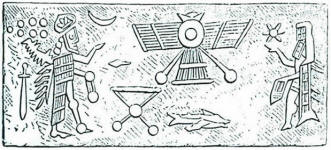
In
The Lost Book of Enki (2004) Zecharia
wrote in regard to the
Face on Mars that it marked the burial place
of an Anunnaki leader named Alalu - that a great rock, fashioned in
the image of his face wearing an astronaut’s helmet, covered a cave
in which the dead Anunnaki leader was laid to rest.
The existence on Mars of large caves (‘caverns’) topped by shaped
rock structures – now revealed by NASA’s new discoveries – was thus
actually written about first in Zecharia’s The Lost Book of Enki
three years earlier.
Going to Mars -First of two
articles-
What is
NASA Looking For?
2004
The planet Mars is back in the news. This time, in spite of
preceding failures (by Japan, Britain) of Mars missions, manmade
Landers and their robotic rovers – NASA’s Spirit and Opportunity --
made it safely and successfully to the Red Planet. A spacecraft
launched by the European Space Agency, Mars Express -– a companion
to the British failed lander/rover mission -– is safely in orbit
around Mars.
And the initial indications, and
photographs, already suggest that the assumption underlying these
missions will be proven true; that Mars was once a planet with water
-– rivers, lakes, perhaps even seas; and that some of that water is
still there.
Although the current explorations on Mars in search of water (then
or even now) have been presented as a new endeavor triggered by
photographs of the surface of Mars taken in 1996 (Mars Global
Surveyor) and since 2001 (Mars Pathfinder), the fact is that
photographs taken two decades and more ago, by the Mariner
spacecraft, already showed such evidence.
In
Genesis Revisited, 1990, I reproduced
NASA’s own photographs to show evidence of water flows and
shorelines, and concluded unequivocally that, at least in the past,
Mars was a watery planet.
Searching for “Life” - So what exactly
is NASA searching for?
Though only indirectly, with
a wink or a Mona Lisa smile, NASA’s leaders say that “where there
was water there could be life.” Officially, they are all just
searching for evidence of water. If water is still there, it would
make it so much more feasible to achieve the vision -– declared by
President George W. Bush –- of sending people from Earth to Mars. A
dream for the future!
In the midst of such exciting developments, it seems to me
appropriate to tell to All Who May Be Concerned: Travel between
Earth and Mars by intelligent beings has already been achieved -–
tens of thousands of years ago!
The Sumerian Evidence
The evidence for that was
recorded –- in words and illustrations -– by the Sumerians, whose
civilization blossomed out in Mesopotamia (now mostly Iraq) some six
thousand years ago.
They did not claim the achievement of visiting Mars for themselves.
Rather, they wrote on their clay tablets about the Anunnaki (“Those
who from Heaven to Earth came”) who came to Earth from their
planet
Nibiru, a twelfth member of our solar system (counting, as they did,
the Sun, Moon and ten planets) whose great elliptical orbit around
the Sun lasts some 3,600 (Earth-) years. The many ancient texts,
unearthed by archeologists, that deal with the Anunnaki, their
comings and goings, and the astronomical knowledge (among other
sciences) that they bequeathed to Mankind, have been revealed and
explained in my series of books, beginning with
The 12th Planet.
Moreover, the texts have been accompanied by illustrations found on
clay tablets or drawn on cylinder seals. In texts dealing with the
actual space travel between the planets, Earth was designated as the
seventh planet – which indeed it is but only if one counts from
outside-in, where Pluto would be the first, Neptune the second,
Uranus and Saturn third and fourth, Jupiter the fifth, Mars the
sixth and Earth the seventh. In those texts, Mars was called “The
Way Station” – a stopover place between Nibiru and Earth.
And, amazingly but true, a circular tablet that can be seen on
display in the British Museum in London, describes in eight segments
various aspects of space travel between the Anunnaki’s planet Nibiru
and the “Seventh Planet” (Earth).
One segment in particular, enlarged here
for clarity, shows (and states) that
the route traveled by Enlil (“Lord of the Command”) entailed passage
by seven planets; it also called for a route diversion between the
planet DILGAN (Jupiter) and APIN (Mars):
 
Mars as a way station
In their texts the Sumerians
wrote that the Anunnaki traveled to Earth in groups of fifty. The
first team, under the leadership of E-A (“Whose home is water”)
splashed down in the waters of the Persian Gulf, waded ashore, end
established ERIDU (“Home in the Faraway”). In time, 600 Anunnaki
were deployed on Earth and another 300 operated shuttlecraft between
Earth and Mars – yes, Mars!
Pictorial evidence for the Earth-Mars connection is provided by a
depiction on a cylinder seal (now kept at the Hermitage Museum in
St. Petersburg, Russia):

It depicts an astronaut (“Eagleman”) on
Earth (the planet marked by the seven dots, accompanied by the
crescent of the Moon) and an astronaut on Mars (the six-pointed star
symbol) –- the latter depicted as one from the “Fishmen” class of
astronauts, those equipped to splashdown in waters.
Between the two planets an object is
depicted, that could only be a spacecraft, with extended panels and
antennas.
A Space Base on Mars
To maintain, over thousands of years,
a space base on Mars required
water for survival. The “Fishman’s” attire of the one on Mars
suggests bodies of water on Mars. Moreover, as detailed in
The Lost Book of Enki (“Lord Earth,” a later title for
Ea),
water was used by the Anunnaki to propel their spacecraft; and the
availability of water on Mars made it a suitable way-station.
The Anunnaki, I have concluded in my books, used Mars not just for a
quick stopover; they created a permanent space base on Mars,
complete with structures and roads. In
Genesis Revisited I
reproduced numerous photographs taken by NASA’s Mariner-9 in 1972
and Viking-1 Orbiter in 1976 that clearly showed a variety of
artificial structures there. Some of them were in the Cydonia area
with its famed “Face.”
Not only such ancient evidence, but NASA’s own photographs from the
1970’s onward, indicated the presence of water on Mars. A search for
watery evidence is thus, no great innovation.
Searching – Or AVOIDING?
The current search for
evidence of water on Mars is hinted as an indirect effort to find
evidence for “life” on Mars. But as in a previous attempt to test
Martian soil (that was deemed unsuccessful), the current one looks
again, at best, for evidence of microbial life.
This impels one to
ask:
Why is NASA not sending its rovers to such areas as
Cydonia,
where its own photographs have shown remains of artificial
structures (to ignore, for a moment, the “Face”)?
As exciting as a discovery that microbes had been on Mars would be
-– isn’t the avoidance of closer looks at areas with structures (and
the Face) indicative of a desire to not find real Life on Mars –-
the life represented by intelligent beings who fashioned us to look
and be like them?
For those who launch the space missions, the word
“Extraterrestrials” remains taboo.
Going to Mars -Second
of two articles
WAS THE
“FACE” DEPICTED 4,500 YEARS AGO?
2004
The successful landing by NASA of two robotic rovers on Mars earlier
this year was an occasion for joy and expectation – joy because so
many of the preceding attempts (including by the Japanese and the
British) have failed, and expectation of obtaining confirmation that
Mars was once a watery planet.
This confirmation was announced by NASA on March 2, 2004. NASA's
spokesman even went as far as stating that "where there was water
there could be life." They speak of course, about bacteria.
Commenting on predictions this would happen, I wrote in a Letter To
The Editor of The New York Times (on January 18, 2004) that even if
NASA succeeds in proving the existence of water in the past,
“it would only affirm what most
people by now believe anyway.”
NASA’s own photographs from the 1970’s
and thereafter have already shown such evidence.
“To conclude that bacteria might
have existed on Mars” (a possibility that would be indicated by
the existence of water), I further wrote in my Letter, “will
hardly excite the public; what would be exciting and highly
significant for mankind’s past and future would be to find
evidence of intelligent life – beings like us – on Mars. The
ancient Sumerians asserted so in their texts inscribed on clay
tablets.
Mariner photographs from the 1970’s
show possible remains of artificial structures (to leave aside
the famed Face). To send rovers to find bacterial evidence
rather than verify evidence for intelligent beings on Mars, e.g.
in
the Cydonia region, is a red-herring cover-up.”
Intriguing Remains in Cydonia
The Letter, not unexpectedly, was not published… But the question
remains; Why had NASA persistently avoided on-site examination of
the Cydonia area?
In Genesis Revisited (1990) I reproduced a series of NASA’s own
photographs, including photo 035-A-72 (Plate “E” in the book) that
captured a panoramic view of Cydonia (see below).
There, clearly, the camera captured a
rock carved to look like a human face, of a male wearing a helmet
(plate “F” in the book) and the remains of walled structures, with
two walls forming a right angle (plate “G” in the book).
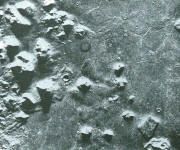
 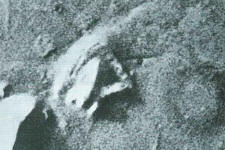
Other NASA photographs reproduced in the
book showed a lake shore, a water channel outfitted with piers, the
remains of a pentagonal structure, of roads leading to elongated
buildings.
Ignoring The Evidence
While in my writings and lectures I emphasized the structural
evidence, it was the Face that captured the interest and imagination
of various individuals and groups. NASA, on its part, ignored all
the evidences in its subsequent missions, focusing instead on
geology. It was only as a result of a public outcry that NASA
finally directed an orbiter, Mars Pathfinder, to take a look at the
Face – but only after a dust storm that covered most of the planet,
and after fiddling electronically with the photographs to end up
with a fuzzy picture.
(Some of the serious work to uncover the
distortions was done by
the Meta Research Institute under the
leadership of the astronomer Thomas Van Flandern).
Yet, now distorted or not, the fact
remains that the unusual rock is still there, and that it clearly
showed a human-like face in the 1970’s photographs.
My conclusions were and still are that intelligent beings akin to us
had been to Mars thousands of years ago. The Sumerians knew who they
were: The same Anunnaki from Nibiru who had come to Earth and
maintained a way-station on Mars.
The Cylinder Seal Depiction
The Sumerian information is provided in texts on clay tablets; and
in pictorial support of my conclusions I included in my books the
rendering of a depiction on a 4,500 years-old cylinder seal, now
kept in the Hermitage Museum in St. Petersburg in Russia:

It shows an astronaut (“Eagleman”) on
Earth (indicated by the seven dots, Earth being the seventh planet
counted from outside into the solar system, accompanied by the
Moon’s crescent) greeted by an astronaut (“Fishman”, equipped for
splashdowns) on Mars (the sixth planet when our solar system is
entered from afar), and a spacecraft with extended panels and
antennas in the heavens between them.
The “Face – 4,500 Years Ago?
It was a discerning fan,
Richard L.C. of Manheim, PA, who drew my attention to the similarity
between the Face in the NASA photographs (yes, there were several
ones) as depicted in Genesis Revisited and the helmeted face of the
astronaut on Mars as depicted on the Sumerian seal; the latter has
been enlarged for better comparison:
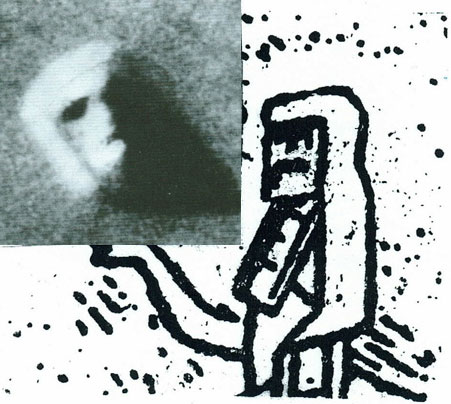
Though one is shown full face and the
other (in the seal) in profile, the similarity is nothing short of
uncanny! Could the Sumerians have known of the Face on Mars 4,500
years ago? The Yes answer is detailed in, The Lost Book of Enki.
It is time to start looking for the Real evidence Mars.
Puzzling
Photographs from Mars Need Explanation!
Sept 2005
NASA has released recent photographs taken by the Mars Rover Spirit,
after it had climbed out of the crater in which it had landed and
took panoramic pictures from the crater’s top. The photographs
captured, according to JPL/NASA, a “dust devil” in the distance
(about 2 miles away).
But as one looks closely at the photographs – there are many of them
– one notices incredible features: What looks like a long
sand-covered wall, a black stone ring, a sand-blown conical structure
& rectangular areas marked off by stone boundaries…
Enlargements of the photos on the JPL/NASA website by Erik Poltorak,
our webmaster, only enhance the puzzle. An explanation by the rover
mission scientists would be most welcome.
Read in
Genesis Revisited about the ancient settlements on Mars.
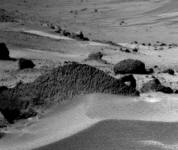 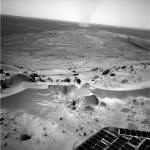 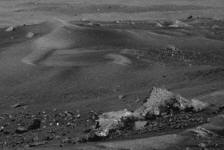

NASA site of Original Images
MARS MYSTERIES
As of now, there has been no response from NASA (or some of the
scientists involved who were personally e-mailed) to the request for
explanation of the incredible photos from Mars taken by the Rover
Spirit and reproduced on this website a month ago.
|












